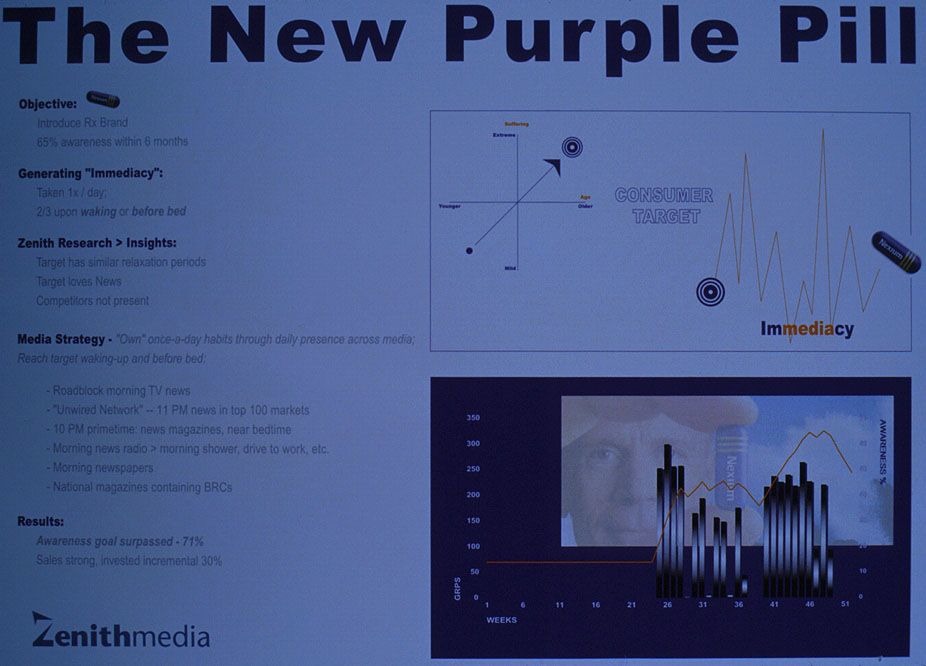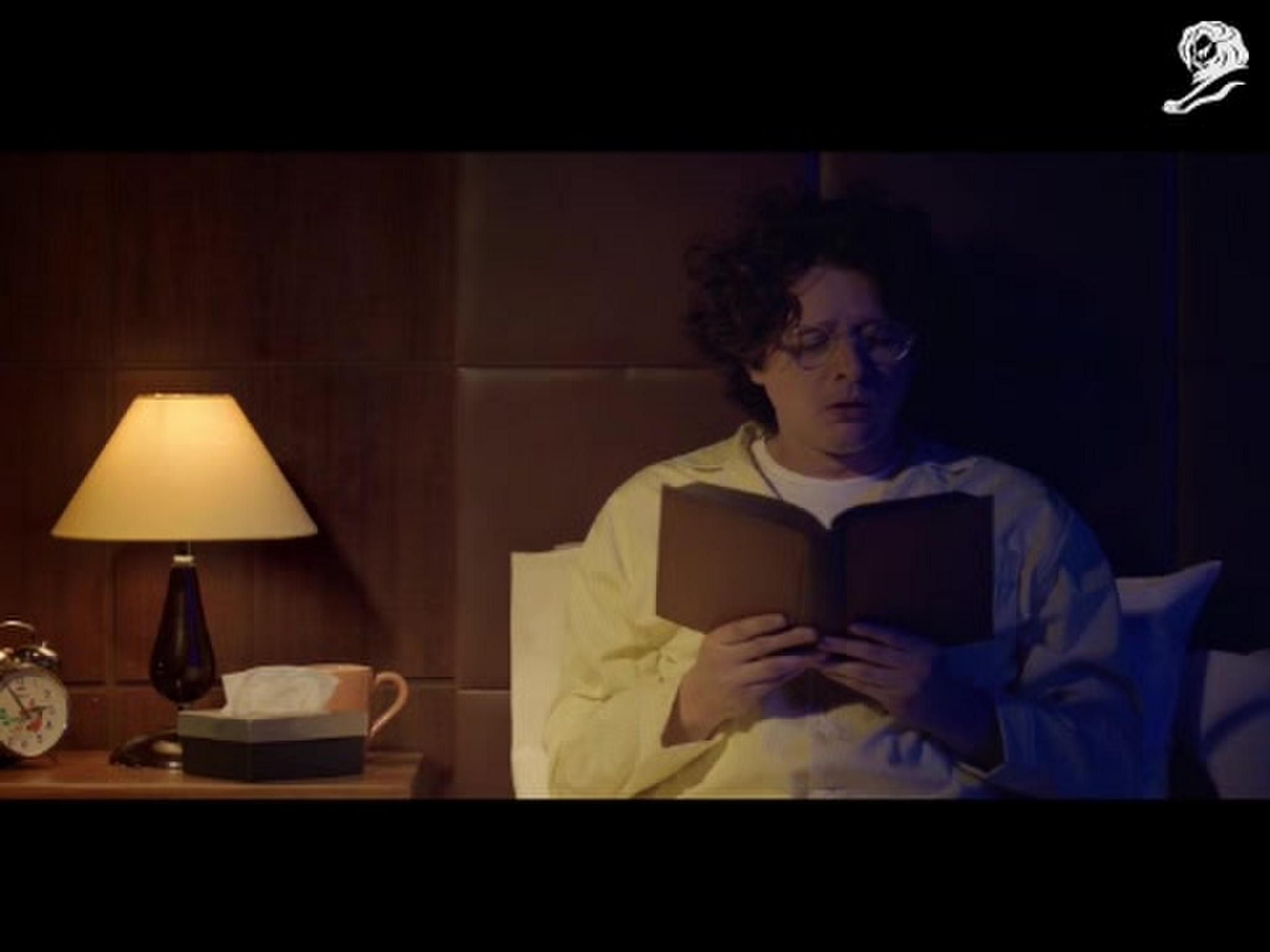Cannes Lions
NEXIUM HEARTBURN DRUG
ZENITH MEDIA SERVICES, New York / ASTRA ZENECA / 2002

Overview
Entries
Credits
OVERVIEW
Description
This effort had multiple goals. First, we needed to successfully launch a successor to one of the world’s most prescribed medications – Prilosec (Losec in some countries). This was the most critical goal as Prilosec will soon be available from other manufacturers in a generic version, and it represented the largest portion of AstraZeneca’s sales (almost $4 Billion). Second, we needed to achieve 65% brand awareness with 6 months of product advertising launch. This was important, as many patients were satisfied with the results they had gotten from using Prilosec. High awareness was very important, as it is the key element in facilitating informed patient/physician discussion. It is consumer demand that pressures physicians to prescribe new treatments. Finally, in order to gain the support of senior management at AZ for future investment behind Nexium, it was critical to meet the goal of having 300,000 individuals request a free trial certificate for a seven-day supply (with a prescription from their doctor). This would be the proof they required showing that the investment in Direct-to-Consumer advertising was worthwhile. The plan was built around “Immediacy”. This term represents the core of our communications strategy, connecting the brand and consumer. The strategy was borne from our most important learnings about heartburn sufferers, the medication and how they interact.The key product proposition is that it’s taken once per day and of those who take it, 2/3 take it either immediately upon waking or immediately before bed. This was put into the context of our target’s media habits (confirmed by syndicated data and Zenith’s proprietary research), their “personal relaxation moments” and a thorough competitive media analysis.When all of these pieces were put together, there was tremendous convergence. Key relaxation moments were heavily concentrated around the same times of day when people were most likely to take their medication – the early morning (frequently the only meal that the family ate together) and late evening (kids busy with homework or asleep, day’s work is done, etc.). Our competitive analysis revealed that in television, our cornerstone medium, competitors weren’t using these dayparts. This was true of radio as well. Finally, through our own research, we discovered that news, in all forms, was very important to our target.The “Immediacy” strategy was executed with the objective of maximizing opportunities to reach consumers when they wake up and before bed. Emphasizing these times allowed us to “own” once-a-day habits through daily presence across multiple media. This led to many key tactics. These included roadblocks every day across the three national morning TV news/talk programs. Further, given that there is no significant national news presence on the broadcast networks near bedtime, we created an “unwired late news network” using 11pm local news programming in the top 100 markets. Further, much of the Primetime purchased revolved around 10pm for two reasons; many of the newsmagazine programs run then and to reinforce the message close to bedtime.In radio, only AM drive was used to complement 1x/day habits of the target (listening while having a morning shower, driving to work, etc.) There was a heavy emphasis on news stations. Morning newspapers were also used during the launch. This was all supported with a strong base of national magazines, where the ads contained business reply cards.Six months after launch (December 2001), the awareness goal was surpassed, reaching 71%. Further, sales were so strong that senior management invested an incremental 30% above the original budget to maximize trial. This campaign was entirely designed by the media team. The genesis of the original idea grew out of a new business pitch for this account. Therefore there was virtually no input from either the client or the creative agency.The media team decided that conducting proprietary research (both dedicated media-only focus groups and Internet polls) would be the best way to develop an understanding of the way heartburn sufferers interact with media. We also used this research to identify moments during the day when our sufferers were most likely to be thinking about their own health and well being, and therefore predisposed to receiving a message about improving their health. It was then critical to build the foundation of the plan around our ability to deliver messages at these key times. We believe this submission is special because it shows the value of conducting proprietary research that is specific to media habits. Had we not done so, the key strategy of reaching people in their preferred media environments, specifically around their times of “personal relaxation” might not have become evident. Our research clearly indicated that focusing on these times could enhance the impact of the advertising, as it would be delivered when it was most relevant to our target audience.It is a great idea because it was designed to break through the incredible explosion of advertising within the Prescription Drug category in which there was $2.5 Billion spent in 2001. Although our budget was large ($100 Million+), that is still a drop in the bucket considering the total.It should be a winner because it helped our client exceed their awareness goals and deliver an incredibly successful launch plan for this new product. It also encouraged senior management of the company to approve an incremental budget (+30%), to continue the momentum past the originally scheduled end of the campaign.
Execution
This campaign was entirely designed by the media team. The genesis of the original idea grew out of a new business pitch for this account. Therefore there was virtually no input from either the client or the creative agency.The media team decided that conducting proprietary research (both dedicated media-only focus groups and Internet polls) would be the best way to develop an understanding of the way heartburn sufferers interact with media. We also used this research to identify moments during the day when our sufferers were most likely to be thinking about their own health and well being, and therefore predisposed to receiving a message about improving their health. It was then critical to build the foundation of the plan around our ability to deliver messages at these key times.
Similar Campaigns
12 items






